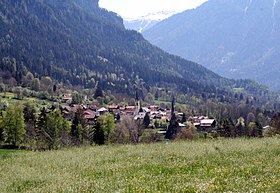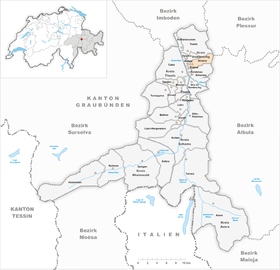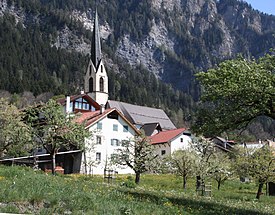Almens
| Almens | ||
|---|---|---|
| State : |
|
|
| Canton : |
|
|
| Region : | Viamala | |
| Circle : | Domleschg - Until December 31, 2017 | |
| Political community : | Domleschg | |
| Postal code : | 7416 | |
| former BFS no. : | 3631 | |
| Coordinates : | 754 187 / 178 211 | |
| Height : | 787 m above sea level M. | |
| Area : | 8.34 km² | |
| Residents: | 225 (December 31, 2014) | |
| Population density : | 27 inhabitants per km² | |
| Website: | www.domleschg.ch | |
|
Almens |
||
| map | ||
|
|
||
Almens ([ ˈalməns ]; Rhaeto-Romanic Almen [ (d) ɐlmˈɛn ]) is a village in the political municipality Domleschg , which lies in the district of Domleschg in the Viamala region in the Swiss canton of Graubünden .
Coat of arms and name
Blazon : In gold (yellow) a rooted green apple tree with three red fruits (according to a seal of the community).
The place name is mentioned in a copy from the 16th century of a document from the first half of the 9th century ( de Lemenne ), in 1156 it appears as Lumins , 1222 as Luminnes , 1329 as Alminze (with an agglutinated preposition and loss of the vowel in the following syllable). It could go back to the pre-Roman personal name Lumenno / Lumenus .
geography
Almens is a clustered village on a slightly sloping terrace above the right side of the Hinterrhein in Domleschg . Of the entire former municipal area of 836 hectares, 380 hectares are forest, 283 hectares of agricultural land (mostly alpine pastures), 159 hectares of unproductive area (mostly mountains) and 14 hectares of settlement area.
Almens bordered on Churwalden , Fürstenau , Scharans , Trans and Vaz / Obervaz .
history
Until December 31, 2014 Almens was a separate political municipality . On January 1, 2015, it merged with the communities of Paspels , Pratval , Rodels and Tomils to form the new community of Domleschg .
population
| year | 1803 | 1850 | 1879 | 1900 | 1910 | 1950 | 1970 | 1980 | 1990 | 2000 | 2004 | 2014 |
|---|---|---|---|---|---|---|---|---|---|---|---|---|
| Residents | 201 (with Pratval, until 1845) | 226 | 270 | 217 | 205 | 252 | 133 | 179 | 200 | 217 | 223 | 225 |
The population rose sharply until 1870, then stagnated for a decade - and then fell sharply until 1910 due to emigration to the industrial areas (1880–1910: −23.5%). But in 1941 it almost reached the level of 1880 again due to constant growth. A second wave of emigration followed from 1950 to 1970, which was even stronger than the first (1950–1970: −47%). The population grew again until 2000. Reasons for this are the relative proximity to the lowlands, the motorization, commuter movement instead of constant emigration and the urge of the urban population for a residence in the country. The number of residents is currently stagnating at just over 200 residents.
languages
Originally the former municipality belonged to the Romansh language area. The language change to German took place around a hundred years ago. Because while in 1888 66% spoke Romansh, in 1920 it was only 44%. Today the former community is almost monolingual German.
| languages | 1980 census | 1990 census | 2000 census | |||
|---|---|---|---|---|---|---|
| number | proportion of | number | proportion of | number | proportion of | |
| German | 158 | 88.27% | 185 | 92.50% | 208 | 95.85% |
| Romansh | 18th | 10.06% | 10 | 5.00% | 6th | 2.76% |
| Residents | 179 | 100% | 200 | 100% | 217 | 100% |
Religions - denominations
Almens belonged to the so-called mixed communities, where part of the population remained Catholic and part followed the Reformed doctrine. Today (as of 2000) there are 68% Evangelical Reformed and 19% Roman Catholic Christians. Another 10% of the population are now non-denominational. 2% of the population gave no information about their creed.
Origin and nationality
At the end of 2005 the former community had 223 residents. Of these, 219 were Swiss nationals and four were immigrants. At the last census, 210 of the population were Swiss citizens - including eleven people with dual citizenship. The few immigrants come from Germany, Italy, Belgium and Portugal.
politics
The municipality president was Andreas Wespi, who now acts as the vice president of the political municipality Domleschg
Attractions
The Catholic parish church of St. Andrew and the Evangelical Reformed village church are listed as historical monuments .
literature
- Erwin Poeschel : The art monuments of the canton of Graubünden III. The valley communities Räzünser Boden, Domleschg, Heinzenberg, Oberhalbstein, Upper and Lower Engadine. (= Art Monuments of Switzerland. Volume 11). Edited by the Society for Swiss Art History GSK. Bern 1940. DNB 760079625 .
- Jürg Simonett: Almens. In: Historical Lexicon of Switzerland . 2016 .
Web links
- Almens on the ETHorama platform
- Official website of the municipality of Almens
Individual evidence
- ↑ a b Andres Kristol: Almens GR (Hinterrhein) In: Dictionnaire toponymique des communes suisses - Lexicon of Swiss community names - Dizionario toponomastico dei comuni svizzeri (DTS | LSG). Center de dialectologie, Université de Neuchâtel, Verlag Huber, Frauenfeld / Stuttgart / Vienna 2005, ISBN 3-7193-1308-5 and Éditions Payot, Lausanne 2005, ISBN 2-601-03336-3 , p. 83. The phonetic transcription given: [ ˈAlʃˌʋiːl ]
- ↑ Domleschg municipality. Retrieved April 28, 2018 .
- ↑ The Catholic parish church of St. Andreas on baukultur.gr.ch




